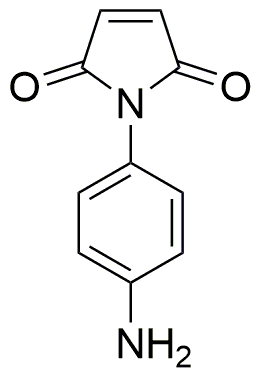N-(4-Aminophenyl)maleimide is widely utilized in research focused on:
- Biomedical Applications: This compound is used in drug development, particularly in creating targeted therapies for cancer. Its ability to selectively bind to certain proteins makes it a valuable tool in designing more effective treatments.
- Polymer Chemistry: It serves as a key component in the synthesis of advanced polymers. These polymers are often used in coatings and adhesives, providing enhanced durability and resistance to environmental factors.
- Diagnostic Tools: N-(4-Aminophenyl)maleimide is employed in the development of diagnostic assays. Its reactivity allows for the labeling of biomolecules, facilitating the detection of diseases at an early stage.
- Material Science: This compound is utilized in creating functional materials, such as sensors and electronic devices. Its unique properties contribute to improved performance and efficiency in these applications.
- Research Reagents: It is commonly used as a reagent in various chemical reactions, aiding researchers in synthesizing other complex compounds, thus expanding the toolkit available for experimental chemistry.
General Information
Properties
Safety and Regulations
Applications
N-(4-Aminophenyl)maleimide is widely utilized in research focused on:
- Biomedical Applications: This compound is used in drug development, particularly in creating targeted therapies for cancer. Its ability to selectively bind to certain proteins makes it a valuable tool in designing more effective treatments.
- Polymer Chemistry: It serves as a key component in the synthesis of advanced polymers. These polymers are often used in coatings and adhesives, providing enhanced durability and resistance to environmental factors.
- Diagnostic Tools: N-(4-Aminophenyl)maleimide is employed in the development of diagnostic assays. Its reactivity allows for the labeling of biomolecules, facilitating the detection of diseases at an early stage.
- Material Science: This compound is utilized in creating functional materials, such as sensors and electronic devices. Its unique properties contribute to improved performance and efficiency in these applications.
- Research Reagents: It is commonly used as a reagent in various chemical reactions, aiding researchers in synthesizing other complex compounds, thus expanding the toolkit available for experimental chemistry.
Documents
Safety Data Sheets (SDS)
The SDS provides comprehensive safety information on handling, storage, and disposal of the product.
Product Specification (PS)
The PS provides a comprehensive breakdown of the product’s properties, including chemical composition, physical state, purity, and storage requirements. It also details acceptable quality ranges and the product's intended applications.
Certificates of Analysis (COA)
Search for Certificates of Analysis (COA) by entering the products Lot Number. Lot and Batch Numbers can be found on a product’s label following the words ‘Lot’ or ‘Batch’.
*Catalog Number
*Lot Number
Certificates Of Origin (COO)
This COO confirms the country where the product was manufactured, and also details the materials and components used in it and whether it is derived from natural, synthetic, or other specific sources. This certificate may be required for customs, trade, and regulatory compliance.
*Catalog Number
*Lot Number
Safety Data Sheets (SDS)
The SDS provides comprehensive safety information on handling, storage, and disposal of the product.
DownloadProduct Specification (PS)
The PS provides a comprehensive breakdown of the product’s properties, including chemical composition, physical state, purity, and storage requirements. It also details acceptable quality ranges and the product's intended applications.
DownloadCertificates of Analysis (COA)
Search for Certificates of Analysis (COA) by entering the products Lot Number. Lot and Batch Numbers can be found on a product’s label following the words ‘Lot’ or ‘Batch’.
*Catalog Number
*Lot Number
Certificates Of Origin (COO)
This COO confirms the country where the product was manufactured, and also details the materials and components used in it and whether it is derived from natural, synthetic, or other specific sources. This certificate may be required for customs, trade, and regulatory compliance.


